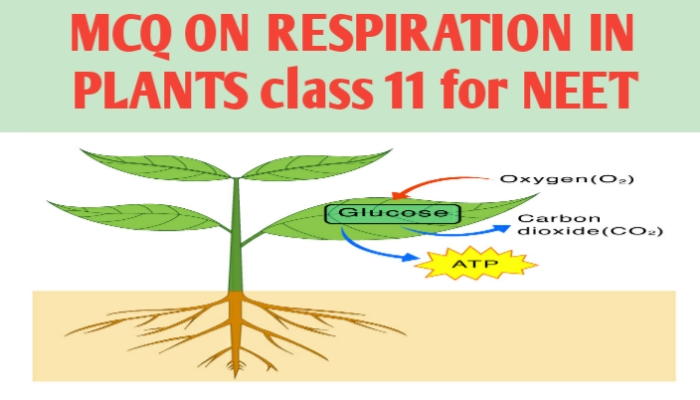MCQ ON RESPIRATION IN PLANTS class 11 for NEET | RESPIRATION IN PLANTS class 11 | MCQ RESPIRATION IN PLANTS with Answer | Check the below NCERT MCQ question for class 11 Biology chapter 14 based on the RESPIRATION IN PLANTS with Answers.
MCQ on RESPIRATION IN PLANTS class 11 Biology with answers were prepared based on the latest pattern.We have provided class 11 Biology MCQs questions on RESPIRATION IN PLANTS with Answers to help students understand the concept very well.

MCQ ON RESPIRATION IN PLANTS class 11 for NEET
MCQ RESPIRATION IN PLANTS is useful for NEET / CSIR / UGC / CBSE / ICSE / AIIMS / EXAM / AFMC EXAM / STATE LEVEL MEDICAL EXAM 2022-23
Introduction:-
All of us breathe to live , but why is breathing so essential to life ? What happens when we breathe ? Also , do all living organisms , including plants and microbes , breathe ? If so, how ?
All living organisms need energy for carrying out daily life activities , be it absorption , transport , movement , reproduction or even breathing . Where does all this energy come from ? We know we eat food for energy but how is this energy taken from food ? How is this energy utilised ? Do all foods give the same amount of energy ? Do plants eat ? Where do plants get their energy from ? And micro- organisms – for their energy requirements , do they eat food.
MCQ ON RESPIRATION IN PLANTS class 11 for NEET
1. A molecule of glucose on complete oxidation yields
(a) 36 ATP
(b) 34 ATP
(c) 40 ATP
(d) 42 ATP
Ans (b) 36 ATP
2.End product of glycolysis is
(a) glucose – 1 phosphate
(b) fructose -1 phosphate
(c) pyruvic acid
(d) acetyl Co A
Ans. (c) pyruvic acid
3. Instant source of energy is
(a) amino acids
(b) fat
(c) glucose
(d) sucrose
Ans. (c) glucose
4. The intermediate between glycolysis and TCA cycle is
(a) pyruvic acid
(b) glucose 1-6 diphosphate
(c) oxaloacetate
(d) acetyl – CoA
Ans.(d) acetyl – CoA
5.Krebs cycle begins with
(a) pyruvic acid
(b) glycogen
(c) lysine
(d) glucose
Ans.(a) pyruvic acid
6. In which part of a mitochondria are succinate dehydrogenase and cytochrome oxidase located
(a) matrix
(b) inner membrane
(c) intermembrane space
(d) outer membrane
Ans.(b) inner membrane
ALSO READ:-
● YOU CAN WATCH BIOLOGY SIR Youtube channel
7. Link between glycolysis , Krebs cycle and beta – oxidation of fatty acids or between carbohydrates and fat metabolism is
(a) oxaloacetic acid
(b) succinic acid
(c) citric acid
(d) acetyl CoA
Ans.(d) acetyl CoA
8. The apparatus used to measure rate of respiration and RQ is called
(a) Auxanometer
(b) Potometer
(c) Respirometer
(d) Manometer
Ans.(c) Respirometer
9. Respiratory quotient is maximum when the respiratory substrate is
(a) Fat
(b) Protein
(c) Glucose
(d) Mallic acid
Ans. (d) Mallic acid
10. Respiratory quotient varies with
(a) temperature
(b) respiratory substrate
(c) light and oxygen
(d) respiratory product
Ans. (b) respiratory substrate
11. Out of 38 ATP molecules produced per glucose molecule , 32 are produced from NADH and FADH2 in
(a) Krebs cycle
(b) ETC
(c) oxidative decarboxylation
(d) EMP
Ans.(b) ETC
12. The fermentation products of glucose formed by yeast are
(a) methyl alcohol and CO2
(b) CO2 and H2O
(c) methyl alcohol and H2O
(d) ethyl alcohol and CO2
Ans.(d) Ethyl alcohol and CO2
13. In animal cell , the first phase in glucose break down is
(a) ETS
(b) Krebs cycle
(c) Glycolysis
(d) Fermentation
Ans. (c) Glycolysis
14. Protein is the substrate in the
(a) aerobic respiration
(b) protoplasmic respiration
(c) seedling stage
(d) floating respiration
Ans.(b) protoplasmic respiration
15. Oxidation of NADH2 yields
(a) 3 ATP
(b) 38 ATP
(c) 1 ATP
(d) 2 ATP
Ans. (a) 3 ATP
16. Which of the following are essential for ATP synthesis.
(a) Fe and Mo
(b) N and P
(c) Fe and P
(d) Mg and Mn
Ans.(c) Fe and P
17. Organism used in the industrial preparation of ethanol is
(a) lactobacillus
(b) azotobacter
(c) penicillium
(d) sachharomyces
Ans.(d) sachharomyces
18. Metabolism of one lipid molecule produces
(a) 36 ATP
(b) 38 ATP
(c) 147 ATP
(d) 56 ATP
And.(c) 147 ATP
19. How many ATP molecules are formed in ETS from the reduced nicotinamide adenine dinucleotide generated in one turn cycle of Krebs cycle ?
(a) 3
(b) 6
(c) 9
(d) 12
Ans. (c) 9
20. The correct sequence of electron acceptor in ATP synthesis is
(a) cytochrome a , a3 , b , c
(b) cytochrome b, c, a, a3
(c) cytochrome b , c , a3 , a
(d) cytochrome c, b , a , a3
Ans.(b) cytochrome b , c , a ,a3







Leave a Comment